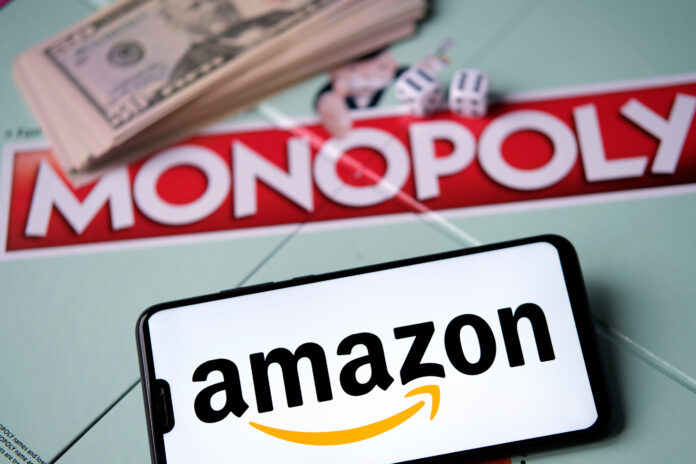Introduction
Amazon’s stronghold on the ecommerce retail market has solidified its monopoly status, leaving sellers with limited choices and facing increasing fees. This article delves into the significant challenges encountered by sellers in the online marketplace, compelled to deal with Amazon to achieve success. Drawing upon the findings of a report revealing Amazon’s growing share of sellers’ revenue and the rising costs of fulfillment fees and advertising, this article sheds light on the concerning implications of Amazon’s dominance. Third-party sellers, who make up 59% of Amazon’s online sales during the first quarter of 2023, have no viable choice but to sell on Amazon if they wish to have a successful Ecommerce retail store. Even rivals such as Walmart and Shopify cannot equal Amazon’s share of the Ecommerce retail market.
Amazon’s Monopoly in Ecommerce R
Amazon’s retail exponential growth and market share have led to its position as the dominant force in the ecommerce sector. The company’s extensive reach, vast customer base, and logistical capabilities make it an attractive platform for sellers seeking to reach a wide audience. However, this dominance comes at a cost, as sellers find themselves in a position where they have limited choices and must rely heavily on Amazon for their online retail operations. Findings from the Investigation of Competition in Digital Markets The “Investigation of Competition in Digital Markets” report released by the House Subcommittee on Antitrust, Commercial and Administrative Law sheds light on the concerning dynamics of Amazon’s control over sellers’ revenues. The report highlights several key findings:
Increasing Share of Sellers’ Revenue: According to the report, Amazon’s share of sellers’ revenue has been steadily growing. The report notes that Amazon is now pocketing over 50% of sellers’ revenue, up from 40% just five years ago. This significant increase puts a substantial strain on sellers’ profitability and raises questions about Amazon’s market power.
Rising Fulfillment Fees: The report also emphasizes the rising costs associated with Amazon’s Fulfillment by Amazon (FBA) service. Fulfillment fees, which include storage and other charges, have consistently increased over the years. This upward trend in fees further limits sellers’ options, as it becomes increasingly challenging to achieve success on Amazon without utilizing FBA.
Compulsory Advertising Expenditure:. The report highlights that the competition for prime screen space on the platform has led to increased advertising costs. As a result, sellers are compelled to allocate a significant portion of their budget to advertising, even if they previously spent minimal amounts on promotional efforts.
Escalating Fees as a Percentage of Sales: Year after year, Amazon sellers face a growing burden of fees relative to their sales. The report reveals that this increase is not solely due to sellers using more services but primarily driven by rising costs of existing services like FBA and the necessity of advertising. These escalating fees impact sellers’ profitability and sustainability.
Amazon’s Total Seller Fees
Based on profit and loss statements provided by a sampling of sellers, typical Amazon sellers face a combination of fees. These include a 15% transaction fee (known as a referral fee), Fulfillment by Amazon (FBA) fees ranging from 20% to 35% (inclusive of storage and other charges), and up to 15% for advertising and promotions on the platform. The specific fees vary based on factors such as category, product price, size, weight, and the seller’s business model.
Stagnant Transaction Fees and Rising Fulfillment Costs
While the transaction fee has remained unchanged for over a decade, FBA fees have experienced consistent increases. Amazon raises fulfillment fees annually and introduces hikes in storage costs. Given the tight integration of selling on Amazon with FBA, sellers find it exceedingly challenging to achieve success on the platform without utilizing this service.
Compulsory Advertising Expenditure
Advertising on Amazon has become an unavoidable necessity for sellers looking to enhance their visibility and attract potential customers. As more sellers opt for advertising, competition for prime screen space intensifies, resulting in increased advertising costs. Most of the highly converting screen space is allocated to advertising, leaving sellers with no choice but to invest in advertising to increase their chances of being discovered. While some sellers still spend minimal amounts on advertising, private label sellers often allocate more than 10% of their sales to promote their brands.
Escalating Fees as a Percentage of Sales
Amazon sellers face a disheartening reality as fees continue to rise, eating up a larger portion of their sales revenue each year. This increase is not solely due to sellers utilizing additional services; rather, it stems from the growing costs of existing services such as FBA and the unavoidable nature of advertising. Consequently, sellers experience diminishing profit margins, hindering their sustainability and overall profitability.
Amazon’s Cut of Sellers’ Revenue
While the fees charged by Amazon contribute to the provision of valuable services, it is worth noting that these services would not be entirely free on other platforms either. Advertising costs on major consumer acquisition channels like Google and Facebook have also risen, and fulfillment services provided by third-party logistics (3PL) companies may not always be more cost-effective than FBA. The fees paid to Amazon encompass a range of essential services, making it challenging to directly compare them to other marketplaces or shopping platforms like Walmart, eBay, or Shopify. Each platform offers a distinct business model, and fees are just one aspect to consider.
Sellers’ Strategies to Combat Fee Increases
To counter the impact of escalating fees, sellers employ various strategies such as raising prices, diversifying away from FBA, or even seeking alternatives to Amazon altogether. However, it is not uncommon for sellers to realize the extent of their diminishing net profits only at the end of the tax year. Some sellers report paying as much as 60% or even 70% of their revenue in fees to Amazon, leaving limited room to cover inventory, shipping, labor costs, and other essential expenses.
Unfair Treatment of Sellers
Third-party sellers on Amazon complain of unfair treatment, including unwarranted suspension of seller accounts, improper deactivation of listings, and a long appeals process that can put a successful Ecommerce retailer out of business, according to Kenneth Eade, supervising attorney of Amazon Sellers Attorney, an Amazon Appeals Service. “They also complain of unconscionable provisions in Amazon’s Business Solutions Agreement,” says Eade, “including a provision which allows Amazon to retain net sellers proceeds, which has been stricken in several arbitration decisions.
Solutions
As sellers’ revenue share for Amazon continues to rise, it becomes imperative to foster a more competitive and diverse marketplace that offers sellers alternative options beyond Amazon. Regulatory efforts to address the concentration of power in Ecommerce platforms like Amazon have gained traction. The aim is to promote fair competition, enhance sellers’ choices, and ensure a level playing field for all participants. By encouraging competition and fostering an environment that empowers sellers, policymakers can help create a more balanced and sustainable ecommerce ecosystem.
As the Ecommerce landscape continues to evolve, it is crucial to strike a balance between supporting the growth of platforms like Amazon while safeguarding the interests of sellers. By promoting competition, transparency, and consumer choice, policymakers can work towards creating a more equitable and competitive environment.
To address the challenges posed by Amazon’s monopoly, various strategies can be explored. One approach is to promote greater transparency in Amazon’s fee structure and provide sellers with more flexibility in choosing services. This could involve implementing regulations that ensure clear and standardized fee disclosures, allowing sellers to make informed decisions about their business operations. Additionally, promoting competition in the Ecommerce marketplace can be achieved by supporting alternative platforms and encouraging the growth of smaller, independent online marketplaces. By diversifying the options available to sellers, they can have more control over their pricing, fulfillment, and advertising strategies, reducing their dependence on a single dominant platform. Another aspect to consider is strengthening antitrust regulations and enforcement.
Conclusion
The “Investigation of Competition in Digital Markets” report highlights the need for scrutiny and potential regulatory interventions to prevent anti-competitive practices that harm sellers and limit consumer choice. By examining market concentration and ensuring fair competition, policymakers can foster an environment where sellers have more negotiating power and alternative platforms can thrive. Furthermore, supporting initiatives that promote seller education, training, and resource-sharing can empower sellers to navigate the challenges posed by Amazon’s dominance. By providing sellers with the tools and knowledge necessary to succeed, they can better adapt to changing market dynamics, explore alternative distribution channels, and potentially reduce their reliance on Amazon.





